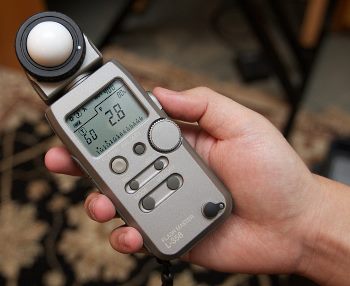property>illuminance
What is Illuminance?

Illuminance is the measure of the intensity of light (also known as luminous flux) incident on a surface of some kind. In the physics of light, an incident ray strikes a surface while a reflected ray leaves the surface and travels back to the observer. Therefore, illuminance is a measure of the total amount of light striking a surface. The standard unit for illuminance is the Lux, or lumen per square meter (lm/m2).
The measurement of illuminance is useful in a wide array of applications, one of which is automatic photography. In order to get the correct exposure, a light meter on a camera has to determine the illuminance of the subject the user intends to take a picture of. There are two main parameters in photography are used to control the amount of light collected during a photographic exposure; the aperture and the shutter speed. With these two factors, many exposure combinations are possible, but only a few of these combinations will yield a correct exposure that makes the best use of the available dynamic range of the film or digital sensor. If the photographer can meter light correctly by measuring illuminance, a more accurate exposure value can be determined to record the image as accurately as possible. Usually this is achieved using an incident light meter, which is a handheld device that includes a translucent dome (integrating sphere) over the sensor. The photographer holds this device in front of the subject to take a reading.
Exposure value, or EV, was designed as a way of equating combinations of aperture and shutter speed that result in the same exposure (have the same EV, numerically). Exposure value is a base-2 logarithmic scale that is functionally related to aperture and shutter speed in the following way:
EV = log2(N2/t)
where N is the f-number of the aperture (f-stop), and t is exposure time in seconds (shutter speed). So, for any given aperture and shutter speed, there is a corresponding exposure value. But this same value is also related to the illuminance of a subject. This relationship is one of correspondence, not equality. That is to say there is a corresponding EV value that matches up best with a particular luminance such that if we were to calculate our EV value based on a measured illuminance and took a picture with the right combination of aperture, shutter speed, and ISO settings (ISO 100 for the correspondence), we would have a “correct” exposure. The equation is written as:
L = 2(EV - 3)
where L is the illuminance of the subject and EV is the exposure value of the photograph. Remember that this correspondence only holds at ISO speed 100.
The measurement of illuminance is also useful in determining the ideal lighting conditions for differing workplaces. A dentist’s office will need to have a certain illuminance value when she is working on her patient’s teeth, and that value will be different from the average office illuminance value. Most offices have an illuminance between 100 and 1,000 lux. A surgeon is likely to illuminate his operating room with 10,000 lux.